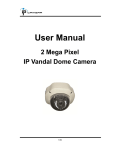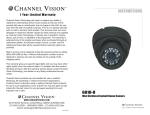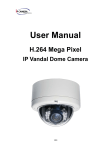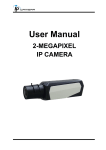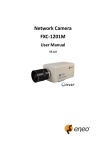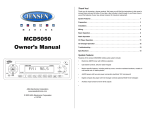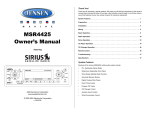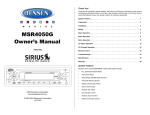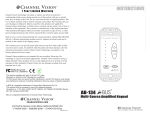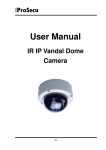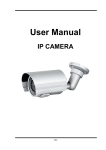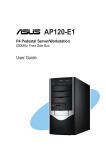Download - Aldous Systems
Transcript
6564/6564H Dome Color Megapixel IP Camera w/IR Illuminators Dome Color Megapixel IP Camera w/IR Illuminators & Heater 6543/6543H Bullet Color Megapixel IP Camera w/IR Illuminators Bullet Color Megapixel IP Camera w/IR Illuminators & Heater Table Of Contents Model Info.................................................................................... Page 3 Safety Warnings.......................................................................... Page 4 Cable Pin Out.............................................................................. Page 5 Assigning An IP Address........................................................... Page 6 Assigning An IP Address continued......................................... Page 7 Assigning An IP Address continued......................................... Page 8 Assigning An IP Address continued......................................... Page 9 Connecting Your Camera........................................................... Page 10 Installing The ActiveX Control................................................... Page 10 Configuring Internet Explorer.................................................... Page 11 Live Viewing................................................................................. Page 12 Live Viewing continued.............................................................. Page 13 Configuration............................................................................... Page 14 System Configuration................................................................. Page 15 User Management....................................................................... Page 16 System Update............................................................................ Page 17 Network........................................................................................ Page 18 Network continued...................................................................... Page 19 Network continued...................................................................... Page 20 Network continued...................................................................... Page 21 Wireless........................................................................................ Page 23 Video Settings............................................................................. Page 24 Video Settings continued........................................................... Page 25 Video Settings continued........................................................... Page 26 Video Settings continued........................................................... Page 27 Video Settings continued........................................................... Page 28 Video Settings continued........................................................... Page 29 Recommended Video Settings................................................... Page 30 Recommended Video Settings/Cont.......................................... Page 31 Event List..................................................................................... Page 32 Event List continued................................................................... Page 33 Schedule...................................................................................... Page 34 I/O Setting.................................................................................... Page 35 I/O Setting continued.................................................................. Page 36 Port Forwarding Example........................................................... Page 37 Specifications.............................................................................. Page 38 2 Models 6564/6543 The 6564 & 6543 are 2 Megapixel bullet and dome CMOS IP cameras. • Built-in web server allows users to view high quality, real-time video with Internet Explorer browser. • Uses H.264, MJPEG and MPEG4 codecs • Live video can be recorded to a computer and played back remotely, as well as viewed from many mobile phones and other devices. • Designed for large commercial projects with 100’s of cameras or a single family house requiring a camera at the front door. • Heater option available in the 6564H and 6543H 6564 Features: Channel Vision’s 6564 Vandal Proof IP Dome offers superior image quality with a 2 megapixel CMOS sensor and has the ability to capture images up to 1080p (1920 x 1080 pixels). With H.264 compression, less bandwidth and storage space are used, while delivering full resolution at max frame rate with faster speeds over the internet. The 6564 also features event triggered SD card recording, as well as 18 IR LED for a viewing distance of 50 feet in total darkness. Monitoring can be done anywhere an internet connection is available even from a 3G Smart-phone 6543 Features: Channel Vision’s 6543 Vandal Proof IP Bullet offers superior image quality with a 2 megapixel CMOS sensor and has the ability to capture images up to 1080p (1920 x 1080 pixels). With H.264 compression, less bandwidth and storage space are used, while delivering full resolution at max frame rate with faster speeds over the internet. The 6543 has a varifocal lens with built-in 35 IR LED for a viewing distance of 60 feet in total darkness Monitoring can be done anywhere an internet connection is available even from a 3G Smart-phone 6564 3 6543 Safety Warnings IMPORTANT SAFETY INSTRUCTIONS 1. Read these instructions. 2. Keep these instructions for future reference. 3. Heed all warnings. 4. Follow all instructions. 5. Clean only with a dry cloth. 6. Install in accordance with these instructions. 7 Do not install near any heat sources such as radiators, heat registers, stoves, or other apparatus that produce heat. 8. Do not defeat the safety purpose of the polarized-type plug. A polarized plug has two blades with one wider than the other. The wide blade or the third prong are provided for your safety. If the provided plug does not fit into your outlet, consult an electrician for replacement of the obsolete outlet. 9. Protect the power cord from being walked on or pinched particularly at plugs, convenience receptacles, and the point of exit from the apparatus. 10. Only use attachments/accessories specified by Channel Vision. 11. Unplug this apparatus during lightning storms or when unused for long periods of time. 12. Refer all servicing to qualified service personnel. Servicing is required when the apparatus has been damaged in any way, such as power supply cord or plug is damaged, liquid has been spilled or objects have fallen into the apparatus, the inside of the apparatus has been exposed to rain or moisture, does not operate normally, or has been dropped. 13. The lightning flash with an arrowhead symbol within an equilateral triangle is intended to alert the user to presence of uninsulated dangerous voltage within the product’s enclosure that may be of sufficient magnitude to constitute a risk of electric shock to persons. 14. The exclamation point within an equilateral triangle is intended to alert the user to the presence of important operating and maintenance accompanying the appliance. 15. Inside of apparatus shall not be exposed to dripping or splashing and objects filled with liquids. CAUTION: To reduce the risk of electric shock, do not remove the cover (or back). There are no user-serviceable parts inside, refer servicing to qualified service personnel. 4 CAUTION RISK OF ELECTRIC SHOCK DO NOT OPEN ! Cable Pin Out DC 12V (Option if not using PoE switch I/O Terminal GND Alarm N.C. Common Ground N.O. Video output Microphone Input Microphone Output Ethernet Connector (T568B Standard) WARNING DO NOT CUT THE BREAKOUT CABLE. CUTTING THE CABLE WILL VOID THE WARRANTY ON THE DEVICE. Channel Vision will still provide technical support if the cable is cut, but cannot guarantee functionality. The breakout cable on Channel Vision’s IP Cameras are used for motion detection, event triggering, alarm notifications etc. The provided interface connections are explained below. 1.) Digital Input (GND+Alarm): An alarm input for connecting devices that can toggle between an open and closed circuit, for example PIRs, door/window contacts, broken glass detectors, etc. When a signal is received, the state changes and the input becomes active. 2.) Relay output (COM +N.O.) / (COM+N.C.) A selectable output for a relay switch, for example LEDs, Sirens, etc. Normally Open and Normally Closed can be selected via the Internet Explorer ActiveX control under the “I/O Setting” section on the left. (See pages 35, 36 for I/O settings) 5 PoE (Power Over Ethernet) Power over Ethernet (PoE) is a technology that integrates power into a standard LAN infrastructure. It enables power to be provided to the network device, such as an IP phone or a network camera, using the same cable that is used for the network connection. The PoE switch eliminates the need for power outlets at the camera locations and enables an easier application of uninterruptible power supplies (UPS) to ensure 24 hours a day, 7 days a week operation. A 802.3af, 15.4W PoE Switch is recommended with 6543 and 6564. If using a PoE switch that does not meet this specification, full functionality may not be supported. 6564 6543 Ethernet Cable Ethernet Cable PoE Ethernet Switch (Not sold by Channel Vision) Power Supply of PoE Switch 6 Assigning an IP Address 1. Use the software, “IP Installer” to assign the IP address to your 6543 or 6564. You can find "IP Installer" in the supplied CD. 2. Execute IP Installer. This is located on your disk under the folder “Megapixel Camera Network Search Application” 3. If Windows prompts you to unblock IP Installer, you must select “unblock” There are 3 kinds of IP configuration A. Fixed IP (Public IP or Virtual IP) B. DHCP (Dynamic IP) C. Dial-up/DSL (PPPoE) "IP Installer" will search all IP Cameras connected to your LAN network.The user can click “Search Device” to search again. 7 Assigning an IP Address /cont 1. Click the start icon on your computer 2. Click the ‘Run’ icon on your computer. 3. Type in ‘cmd’ and press enter on your keyboard, or press ok. 4. Type in ‘ipconfig /all’ into the DOS prompt that appears. Press enter. 5. Write down your computer’s IP address. It is important that we do not use the same IP address for our IP Camera. In the example below, the computer’s IP address is 192.168.1.74. The IP address of the IP Camera must be different than the IP address in the computer. Each networkable device in your network has an IP address assigned. You need to be sure the IP you choose for your IP camera is not the same as any other device on your network. 8 Assigning an IP Address /cont 6. Copy/write down the following information from the DOS prompt. A. Default Gateway (Example 192.168.1.1) B. DNS Server (if 2 servers, use the first one, for example 192.168.1.9) C. Subnet Mask (Example 255.255.255.0) 9 Assigning an IP Address /cont 7. Enter the information you wrote down from step 6 on page 9 into the IP camera network page A. Default Gateway (Enter this number under “Gateway”) B. DNS Server (Enter this number under “DNS 1”) C. Subnet Mask (Enter this number under “Netmask”) 8. Giving the IP Camera a unique IP address. Assign an IP address to the IP Camera by using the first 3 sets of numbers of your default gateway. A IP address, has 4 sets of numbers, each followed by a period. For example, xxx.xxx.xxx.xxx My default gateway is 192.168.1.1 So, for example, my IP Camera’s address will start with 192.168.1.xxx 9. Make sure you use a number different that your computer’s IP address. (Generally between 2-250) This number needs to be out of the range of DHCP. DHCP is assigned with your router, and can be checked by logging into the router. My computer’s IP address is 192.168.1.74. I have used 192.168.1.208 for my IP Camera. You must choose a number that is different from your computer’s IP. If your IT technician has designated a static internal IP for your IP Camera, use that address. 10. To assign the port, choose a port between 5400-9000, and type it into “Port 1” If a specific port has been designated for your security system, that can also be used, even if the number is not within the range of 5400-9000. First 3 numbers are same as computer Select “Static” Name Fourth number (different than computer) Subnet Mask (same as computer) Default Gateway (same as computer) DNS Server 1 (same as computer) DNS Server 2 (same as computer) Port (A port between 8000-8999 is recommended, but any network port can be used) To change numbers, select the appropriate area on IP installer with your mouse, and type in the info. *Disclaimer: This is an example based on a general network setup. All networks do not match these settings exactly, as all networks are different 10 Connecting To Your Camera 1. Open Internet Explorer. Type the IP address of the IP camera into the browser link window. Also, make sure to type the port at the end of the link. For example, I will type in http://192.168.1.207:8005 2. You will be prompted for a username and password. The default username is ‘admin’ The default password is ‘admin’ Installing The ActiveX Control 1. The first time you connect to the camera via Internet Explorer, it will ask you to install the ActiveX control. Internet Explorer 6, 7, 8, or 9 must be used to run this ActiveX control. 11 Configuring Internet Explorer If the installation of the ActiveX control fails, for example the browser page says “done” but you do not see your camera, please check the security settings for your IE browser. Follow the instructions below. Step 1 Step 2 Step 3 Step 4 When the following dialogue box pops up , click “Yes”. 12 Step 5 Live Viewing Once you connect to your camera, you will see the following screen. Below the icons and their functionality are defined. Snapshot Settings Shows the number of users connected at any given time Controls the selection of the video stream that is being viewed Activates 2-way audio Controls the physical size of the streaming video on the browser screen Format: Year/Month/Day/Hour/Minute/Second/ Image Size/Frames Per Second 13 Activates relay output Live Viewing/cont. 1. This icon opens the settings menu 2. This icon takes a snapshot 3. This icon shows system time, video resolution, and video refreshing rate 4. The bottom bar has an icon that allows you to select which stream you want to view. Stream 1 is usually the larger, better quality stream. Stream 2 is the smaller stream, generally used for mobile viewing 5. These cameras support 2 way audio. The bottom bar has an icon that will will activate 2 way audio For 2 way audio to function, you will need a microphone plugged into the computer. 6. The bottom bar has an icon shows how many users are connected to the IP camera. 7. This icon will control/activate the relay output on the camera wire pigtail. A relay can activate lights, alarms, or anything that uses a contact closure. 8. If you double click the video feed, it will make the video full screen. To change video back to normal mode, press ‘Escape’ on your keyboard, or double click anywhere in the video feed a second time. 9. If you right click on the video, you have access to several different functions. A. Snapshot: Takes a snapshot B. Record Start : Records video to your computer C. Mute: Mutes 2 way audio, if activated D. Full Screen: Makes the IP camera full screen E. Zoom: Digital zoom. This is explained below F. Frame BuffmSec: This changes the frame buffer rate Digital zoom 1. Select “Enable digital zoom” 2. Select the area of the screen you wish to zoom in on 3. Select the zoom level 1 3 14 2 Configuration 1 1. Select this icon to enter the settings menu 2. Select this icon to go back to your live video feed 15 2 System Configuration System Information: Use the number scheme below for a description of each item: 1. MAC Address: (Media Access Control) address; This is a unique identifier assigned to IP devices for communication with the network. Your IP camera is pre-set with a MAC address 2. Server name: Select to edit the camera name 3. LED Indicator: Select On/Off to toggle the blinking LED light in the camera 4. Language: Select a language to change the language of the ActiveX interface 5. Status Bar: Select On/Off to toggle the information bar (below the main video stream) 6. Time Stamp: Select Enabled/Disabled to turn the video timestamp on or off 7. Text: Select Enabled/Disabled to specify the name that can be displayed on the top left area of the screen 8. Server Time: This shows the current time on your IP camera 9. Date Format: Select to choose your desired date format 10. Time Zone: This shows your current time zone 11. NTP: The Network Time Protocol is a protocol for synchronizing the clocks of computer systems 12. NTP Server: If you have a NTP server, input it here 13. Update: If using an NTP server, select this drop down menu to choose the update interval 14. Time Shift: Time shift is used to compensate for the time it takes to server to process the sync request for your time. This is usually not needed. 15. Synchronize with PC’s time: Select this to match your computer’s clock to your IP camera 16. Apply: Select this button to save your changes 1 5 2 3 4 6 7 8 9 10 11 12 13 14 15 16 16 User Management User managment: This IP camera supports 3 different types of users. 1. Administrator 2. General 3. Anonymous Click “Yes” to allow anonymous user access Click “Add/Set” to add a user Click “Edit” to modify a user. When you click edit, the following window will pop up: (Shown below.) Add the username and password, and click “OK” to save your new user. 17 System Update System Update: This menu is used to perform the following functions: 1. Firmware Update: Channel Vision will update the firmware from time to time. By registering your IP camera, you have access to all firmware improvements and extended warranty options. How? See the product page on www.channelvision.com To load new firmware, press “Browse” and select the firmware.bin file. 2. Restart System: Select to restart system. You can reset the IP camera to factory default settings if desired If you backup your settings, you can load your backup file where it says “New Setting File” 3. Settings backup: You can backup your settings by right clicking your mouse on “Setting Download” and selecting “Save Target As”. You may also load previously saved settings files this way. When loading previously saved files, click “Browse” and then “Upgrade” 18 Network Network Setup/IP Setting: This setting is for the external viewing of camera over the internet. Once set up, you will be able to view this camera from anywhere in the world. This IP camera supports DHCP and Static settings. If you are new to installing an IP camera, use #2 (Static IP) 1. DHCP: If you use this setting, your IP information will be pulled automatically from your router. This not recommended if you are going to view this camera outside of the building that it resides in. 2. Static IP: This is an IP that you manually set. This IP must not be the same as any other device within your network. You must also set default gateway, DNS server, subnet mask, and DNS server. Please refer to page 6 & 7 for instructions on how to obtain these numbers. 3. Port Assignment: You can assign different ports for your camera. (Explained below.) A. Web Page Port: (This is the port that 99% of installations will use) A web page port is used to transmit data out of your network. For example, If my external IP address is http://67.88.12.50, and my port was 5400, I would put a “:” and the port. The final address would be http://67.88.12.50:5400 B. RTSP Transmitting Port: Port for RTSP stream. C. RTP start and end port: In RTSP mode, you may use TCP and UDP for connecting TCP connection uses RTSP port (554) UDP connection uses RTP start & end port. 4. UPnP: This IP camera supports UPnP. If this service is enabled on your computer, the camera will be automatically detected and a new icon will be added to “My Network Places”. Below are instructions on how to activate UPnP on your computer: A. Open the control panel from the start menu. B. Select “Add/Remove programs” C. Select “Add/Remove Windows components” D. Open “Networking Services” section E. Click “Details” and select UPnP to setup the service. F. Once activated, the IP camera icon will appear in “My Network Places” G. You can now double click that icon to access the camera with your IE browser. 19 Network/cont Network/cont: Below is an example of the network settings menu. This is where you key in all of your IP information from your network. These settings must be entered correctly in order for the IP camera to be viewable over the network. 5. PPPoE: Check the PPPoE “Enabled” button to activate this function. You can key in a username and password for the connection if you are using ADSL. Send mail after dialed: When connected to the internet, this IP camera will send a email to the specified email account. To configure the IP camera email settings, please refer to the “Mail and FTP Settings” 20 Network/cont Network/cont: DDNS: This IP camera supports DDNS (Dynamic DNS) service. Select “Enabled” to enable the DDNS service. For viewing the cameras over the internet while using a dynamic (rotating) IP address, there are many services available online. 1. Enable the service 2. Key in the DynDNS server name, username, and password 3. Set up the IP update refresh rate 4. Click “Apply” 5. If it updates to often, the IP will be blocked by DynDNS Channel Vision recommends you set it to update once per day (1,440 minutes) 21 Network/cont Mail & FTP: Enter your Mail and FTP information into the menu below: Mail: Mail is a way the IP camera can send you an email when certain actions occur, for example motion, a contact closure on the sensor, etc. For more details, please see page 32 FTP: FTP is for uploading recorded files to a designated FTP site Please note: standard free web mail email services block devices such like this, due to spam settings. 22 Video Settings Image Setting: You can adjust the following items on this camera: 1. 2. 3. 4 5. 6. 7. 8 9. 10. 11. 12. 13. 14. Brightness: This adjusts the brightness level of the camera Contrast: This adjusts the difference in color and light between parts of an image Hue: This adjusts the hue of the camera Saturation: This adjusts the color saturation of the camera. Sharpness: This adjusts how sharp the image appears AGC: This adjusts the automatic gain control Shutter Time: This adjust the shutter speed to reflect various lighting conditions Sense-Up: This allows adjustments of selectable digital slow shutter speeds D-WDR: This adjusts digital WDR Video Orientation: This adjusts video orientation Day & Night: This allows many options for manually setting camera mode Night to Day Lux: This allows manual setting of day and night lux levels Current Lux: This tells you what your current lux level is DNR: This allows adjustment of digital noise reduction 1 2 3 4 5 6 7 8 9 10 11 12 13 14 You can reset your IP camera’s image settings to default by pressing the “default” button 23 Video Settings/cont. The 6543 and 6565 IP cameras are varifocal. This means you can adjust the zoom and focus level of the camera from 3-9mm on the 6564 and 3.6-16mm on the 6543 How to adjust zoom and focus on the 6543 Focus Zoom 1. Using a flat head screwdriver, adjust the zoom or focus screws on the 6543 camera 24 Video Settings/cont. To adjust zoom and focus on the 6564, first, you have to take off the plastic dome piece. To do this, unscrew the 4 vandal resistant screws using the tool that comes with the 6564. 6564 How to adjust zoom and focus on the 6564 2 2 Focus Zoom 1. You will need to unscrew each of the knobs slightly (counter-clockwise) with your fingers or a flat head screwdriver. If you do not unscrew the knobs first, you will be unable to move them 2. Once you have loosened the zoom or focus knob, use the knob as a lever to turn the circular lens piece 3. Once you are done adjusting your zoom and focus, screw the knobs back in (clockwise) 25 Video Settings/cont. Video Setting: Click the drop down list to select Video System Streaming: Basic mode: 1. Resolution: There are 5 resolutions you can choose from. 1920x1080, 1280x720, 640x480, 320x240, & 176x144 2. Quality: There are 5 levels you can adjust to: Best, High, Standard, Medium, & Low. If you use the highest settings, the network streaming speed will be slower Also, if you record any files, the higher the quality, the larger the file will be 3. Video Frame Rate: The video refresh rate per second. Setting max is 30 FPS 4. Video Format: This describes the codec use for compression. H.264 is newer and higher quality, and MJPEG (JPEG) is an older, but still commonly used codec 5. RTSP Path: RTSP output name. For example, if I choose camera, the rtsp path would be as follows: rtsp://camera/V2 26 Video Settings/cont. Streaming (Advanced Mode): 1. Resolution: There are 5 resolutions you can choose from. (1080p) 1920x1080 (WXGA) 1280x720 (VGA) 640x480 320x240 (qVGA) 176x144 (qCIF) 2. Bitrate Control mode: There are 2 choices. CBR (Constant Bit Rate) and VBR (Variable Bit Rate) A. CBR: 32Kbps-4Mbps (The higher the CBR, the better your video quality will be) B. VBR: 1 (Low) -10 (High) Compression rate. The higher the compression rate the higher the picture quality, and vice versa. The balance between VBR and network bandwidth will affect your picture quality. When using VBR, it is less likely that your streaming video will break up or lag. 3. Video Frame Rate: The video refreshing rate per second NTSC: Max 30 frames per second PAL: Max 25 Frames per second 4. GOP Size: This means ‘Group of Pictures.” The higher the GOP is, the better the quality of the images 5. Video Format: This describes the codec use for compression. H.264 is newer and higher quality, and MJPEG (JPEG) is older, but will stream faster 6. RTSP Path: RTSP output connecting route 27 Video Settings/cont. Stream 2 (Basic Mode): 1. Resolution: There are 5 resolutions you can choose from. (1080p) 1920x1080 (WXGA) 1280x720 (VGA) 640x480 320x240 (qVGA) 176x144 (qCIF) 2. Quality: There are 5 levels you can adjust to: Best, High, Standard, Medium, & Low If you use the highest settings, the network streaming speed will be slower Also, if you record any files, the higher the quality, the larger the file will be 3. Video Frame Rate: The video refreshing rate per second 4. Video Format: This describes the codec use for compression. H.264 is newer and higher quality, and MJPEG (JPEG) is older, but may stream faster 5. RTSP Path: RTSP output connecting route For example, rtsp://camera/v2 28 Video Settings/cont Stream 2 Advanced Mode: 1. Resolution: There are 5 resolutions you can choose from. 1920x1080,1280x720, 640x480, 320x240, & 176x144 2. Bitrate Control mode: There are 2 choices. CBR (Constant Bit Rate) and VBR (Variable Bit Rate) 3. Video Frame Rate: The video refreshing rate per second. 4. GOP Size: This means ‘Group of Pictures.” The higher the GOP is, the better the quality of the images. 5. Video Format: This describes the codec use for compression. H.264 is newer and higher quality, and MJPEG (JPEG) is older, but may stream faster. 6. RTSP Path: RTSP output connecting route. 3GPP Streaming Mode: 1. Enable or Disable 3GPP Streaming 2. 3GPP: 3GPP output name *Channel Vision recommends you use 176x144 resolution, 5FPS, MPEG4 format for 3GPP mode 29 Recommended Video Settings Below are a few examples of recommended settings, depending on the situation. 1. Viewing a stationary object, or area that does not receive much movement If the camera is looking at a stationary object, or an area that does not receive a lot of traffic or movement, the camera can be set to the highest settings. An example of the highest settings are below: 2. Viewing an area that receives a lot of traffic or movement If the camera is looking at an area that views constant or near constant movement, a medium setting is recommended. An example of medium settings are below: 30 Recommended Video Settings/cont 3. Viewing a 6543 or 6564 on a slow internet connection If the 6543 or 6564 is installed on a network that does not have a very fast internet connection, or you are viewing on a network with limited bandwidth, the example below is recommended. 4. Viewing a 6543 or 6564 on the lowest settings Below is an example of the lowest settings. 31 Audio Audio: Most Channel Vision IP Cameras support 2-way audio, allowing you to listen with an external microphone and speak through powered speakers using your PC, both internally in your network, as well as remotely over the internet. You can send audio from the IP camera to the PC you are connected to. You can also send audio from the PC to the IP camera. This audio output on the camera is located on the camera pigtail. You would need to connect to an amplifier, for example the A0240. To send audio from the PC to the IP camera, you need a standard microphone plugged into the computer, for example a 5104-MIC. You can also plug a microphone directly into the IP camera to feed the A0240 directly. A0240 (Amplifier) 6564 Speaker Wire 5104-MIC VC-302 (Volume Control) 32 Audio/cont Audio: Below are instructions on how to enable audio on your IP camera. Select “Enabled” to activate audio from the camera to your PC Select “Chatting” to activate audio from your PC to the audio output of your IP camera *While recording to an SD card on the IP camera, audio playback will be choppy. 33 Event List 1.) Event Setting: The purpose of this menu is to configure what the camera will do when an “event” is generated. 2.) Motion Detection The 6564 & 6543 allow 3 areas of motion detection. (Area Setting) When motion is triggered, they can send the video, in the form of events to a specific mail address, transmit the live video to a remote FTP server, trigger a relay, and save events in the form of video to local SD card. (SD Card recording only available with the 6564 dome camera) To set up the motion area, click “Area Setting”. Use the mouse to click and drag a box of the area you want to select.The same method is used for area 2 and area 3. .3.) Record File Setting: The 6564 & 6543 allow 3 different types of recording files. A.) AVI File (With time stamp) This is the largest file size option to choose, but the video will be the highest quality available. B.) JPEG (MJPEG) File (With time stamp) This is a smaller file size to choose, but is of lower quality than the AVI format. C.) JPEG (MJPEG) Single file with interval setting. 34 Event List/cont. 4.) Record Time Setting: Pre Alarm and Post Alarm setups for record start and end time when motion is detected, or to trigger a relay. Note: Pre/Post Alarm record time based on record time setting and 6543 or 6564's built-in memory. The ability to store data is limited, so if the video quality is set very high, this will cause a drop in the recorded FPS. This will also decrease pre or post recording time. 5.) Network IP Check: This option serves two functions. One, it checks your internet connection (Interval) to make sure your network connection has not been lost. Two, if your connection is lost, you can set this to automatically record to the SD card until it is full. “IP Check” enables or disables this feature. “IP Address” is what the camera will use to check if the internet is still working. “Interval” is how often the camera will test your internet connection. “IP Check” (lower option) has a box to check. When you check this box, you will record to your SD card upon network failure. 35 Schedule 1.) Schedule: Complete schedule setup to tell the 6564 or 6543 when to record data. 2.) Snapshot: After enabling the snapshot function, user can select the storage location of the snapshot, the time of snapshot, and the file name of snapshot. Click “Enabled” to enable snapshot. Select the E-mail, FTP, or Save to SD card option to enable. Click the desired areas (boxes) to designate recording time. Green=record 36 I/O Setting I/O Setting: The 6564 & 6543 supports 1 input/1 output. When the input is triggered, it can send the video to a specific e-mail address, (only one receiver email is allowed) transmit the video to remote ftp server, trigger the relay, and save video to local SD card. Alarm Input Setting: The GPIO I/O port input activates related functions when I/O input is triggered GPIO Output Setting: The GPIO I/O port output activates a switch, slide switch or pan/tilt Module for use with any standard relay box GPIO 0 GPIO 1 GPIO 2 GPIO 3 37 ALARM INPUT Normal: 3.3V (The voltage differential from GPIO pin & GND) Active: 0V (GPIO 0 & GPIO1 link to PIN2 GND) ALARM OUTPUT Normal: 3.3V (The voltage differential from GPIO pin & GND) Active: 0V (GPIO 0 & GPIO1 link to PIN2 GND) I/O Setting/cont I/O Setting: The 6564 & 6543 support 1 input/1 output. When a input is triggered, it can send the video to a specific email address, transmit the video to remote ftp server, trigger the relay, or save video to your SD card. (Note: 6564 dome offers an SD card option, 6543 bullet does not) GPIO INSTALLATION EXAMPLE 1: Floodlight Trigger a normally off (Normally Open) alarm siren that activates when an event/motion occur at the COM terminal. GPIO INSTALLATION EXAMPLE 2: Light Bulb Trigger the normal on (Normally Closed) indoor light off when an event/motion occurs on the COM terminal. Log List Log List: This menu provides access to the logs the IP camera will create. 38 SD Card Recommended SD Cards : SanDisk 128M SanDisk 256M SanDisk 512M SanDisk 1G SanDisk 2G SanDisk 4G Tracend 128M 80X Tracend 256M 80X Tracend 512M 80X Tracend 1G 80X Tracend 2G 80X Tracend 4G 80X Using the SD card could affect the frame rate of the video. Make sure the SD card is pushed into the slot completely. The capacity of the SD card is shown in the SD card menu. Below is a list of the video files recorded. The video format recorded to the SD card is AVI. Double click the video to open Windows Media Player and play the selected file. To delete the video, check it with the mouse, then click the Del. When the SD card is full, it will automatically delete the oldest video files. 39 Port Forwarding In order to view the IP camera from outside of your home or business network, port forwarding configuration will be required in your router. Port Forwarding LG Routers In the example below, there is a IP camera running on port 8002 on the LAN. 1.) Add the IP information, including the desired port into the port forwarding tab of “advanced” in the router 2.) Check “Enable Port Forwarding” 3.) Click ‘Add” 4.) Click “Select” 5.) Select “Apply” to enable your new port forwarding rule 40 6564/6564H Specifications Image Sensor: 1/2.7” CMOS (2 Megapixel) Lens: 3-9mm Varifocal F1.8 Sensitivity: Color: 0.1 lux (AGC on) B/W 0 lux (IR on) IR Distance: 18 LEDs, max distance 15 meters Angle of View: 35.5°-126.8° (H) x 21.6° - 69.4° (V) Video Compression: H.264, MJPEG, MPEG-4 (3GPP only for MPEG-4) Max Resolution: 1920x1080 Supported Resolutions: 1920x1080, 1280x720, 640x480, 320x240 & 176x144 Audio Compression: G.711 (64k) or G.726 (24/32k) Audio: Input, audio input 3.5mm line level) Output (3.5mm line level) 2-way audio supported I/O: D1 x1 / DO x1 Security: Password protection, IP address filtering, HTTPS encrypted, 802.1x port based authentication for network protection, & QoS/DSCP Network Protocol: Ipv6, Ipv4, TCP/IP, UDP, SMTP, FTP, PPPoE, DHCP, DDNS, NTP, UPnP, 3GPP, Samba, & Bonjour DC Power Consumption: 7.08 watts (IR off, heater on) 8.28 watts (IR & heater on) 4.08 watts (IR & heater off) 5.52 watts (IR on, heater off) (Heater option only available in 6543H) POE Power Consumption: 8.64 watts (IR off, heater on) 10.56 watts (IR & heater on) 5.28 watts (IR off, heater off) 6.72watts (IR on, heater off) (Heater option only available in 6543H) Bracket: 3-Axis bracket Vandal Proof: Yes IP Rating: IP66 Motion Detection: Yes, digital only SD Cards Supported: Micro SD 32GB (max tested; Trancend, Scandisk) Operating Temperature: -30° to 50° Celsius; -22° to 122° Fahrenheit with heater (6564H) 0° - 40° Celsius / 32° - 104° Fahrenheit without heater (6564) Heater: Yes Video Output: Composite, BNC Maximum Users: 10 Dimensions: System Requirements OS: Windows 2000, XP, Vista, 7 Browser: Microsoft IE 6.0 or above Suggested Hardware: Intel Dual Core 1.66G,RAM: 1024MB, Graphic card: 128MB Minimum Hardware: Intel-C 2.8G, RAM: 512MB, Graphic card: 64MB 41 6543/6543H Specifications Image Sensor: 1/2.7” CMOS (2 Megapixel) Lens: 3.6-16mm Varifocal F1.8 Sensitivity: Color: 0.1 lux (AGC on) B/W: 0 Lux (IR on) IR Distance: 35 IR LEDs, max distance 18 meters Angle of View: 23.6° - 97.9° (H) x 14.2° - 51.6° (V) I/O: 1 D1 / 1DO Video Output: BNC, composite video Audio: Input, audio input 3.5mm line level) Output (3.5mm line level) 2-way audio supported Audio Compression: G.711 (64k) or G.726 (24/32k) Video Compression: H.264, MJPEG, MPEG-4 (3GPP only for MPEG-4) Dimensions: DC Power Consumption: 3.26” (W) x 7.1” (L) 10.6 watts (IR off, heater on) 11.96 watts (IR & heater on) 3.8 watts (IR & heater off) 5.76 watts (IR on, heater off) (Heater option only available in 6543H) POE Power Consumption: 13.28 watts (IR off, heater on) 15.17 watts (IR & heater on) 4.8 watts (IR off, heater off) 7.68 watts (IR on, heater off) (Heater option only available in 6543H) Max Resolution: 1920x1080 (30 FPS) Supported Resolutions: 1920x1080, 1280x720, 640x480, 320x240 & 176x144 Security: Password protection, IP address filtering, HTTPS encrypted, 802.1x port based authentication for network protection, & QoS/DSCP Network Protocol: Ipv6, Ipv4, TCP/IP, UDP, SMTP, FTP, PPPoE, DHCP, DDNS, NTP, UPnP, 3GPP, Samba, & Bonjour Vandal Proof: Yes IP Rating: IP66 Motion Detection: Yes, digital only Operating Temperature: -40° to 50° Celsius; -40° to 122° Fahrenheit with heater (6543H) 0° - 40° Celsius / 32° - 104° Fahrenheit without heater (6543) Heater: Yes Maximum Users: 10 SD Cards Supported: Micro SD 32GB (max tested; Trancend, Scandisk) System Requirements OS: Windows 2000, XP, Vista, 7 Browser: Microsoft IE 6.0 or above Suggested Hardware: Intel Dual Core 1.66G,RAM: 1024MB, Graphic card: 128MB Minimum Hardware: Intel-C 2.8G, RAM: 512MB, Graphic card: 64MB 42 1 Channel Vision Technology will repair or replace any defect in material or workmanship which occurs during normal use of this product with new or rebuilt parts, free of charge in the USA, for one year from the date of original purchase. This is a no hassle warranty with no mail in warranty card needed. This warranty does not cover damages in shipment, failures caused by other products not supplied by Channel Vision Technology, or failures due to accident, misuse, abuse, or alteration of the equipment. This warranty is extended only to the original purchaser, and a purchase receipt, invoice, or other proof of original purchase date will be required before warranty repairs are provided. Mail in service can be obtained during the warranty period by calling (800) 8400288 toll free. A Return Authorization number must be obtained in advance and can be marked on the outside of the shipping carton. This warranty gives you specific legal rights and you may have other rights (which vary from state to state). If a problem with this product develops during or after the warranty period, please contact Channel Vision Technology, your dealer or any factory-authorized service center. Channel Vision products are not intended for use in medical, lifesaving, life sustaining or critical environment applications. Channel Vision customers using or selling Channel Vision products for use in such applications do so at their own risk and agree to fully indemnify Channel Vision for any damages resulting from such improper use or sale. Tested To Comply With FCC Standards This device complies with part 15 of the FCC rules. Operation is subject to the following two conditions: (1) This device may not cause harmful interference, and (2) This device must accept any interference received, including interference that may cause undesired operation. www.channelvision.com 234 Fischer Avenue, Costa Mesa, California 92626 USA (714)424-6500 (800)840-0288 (714)424-6510 fax email: [email protected] 500-322 rev C













































